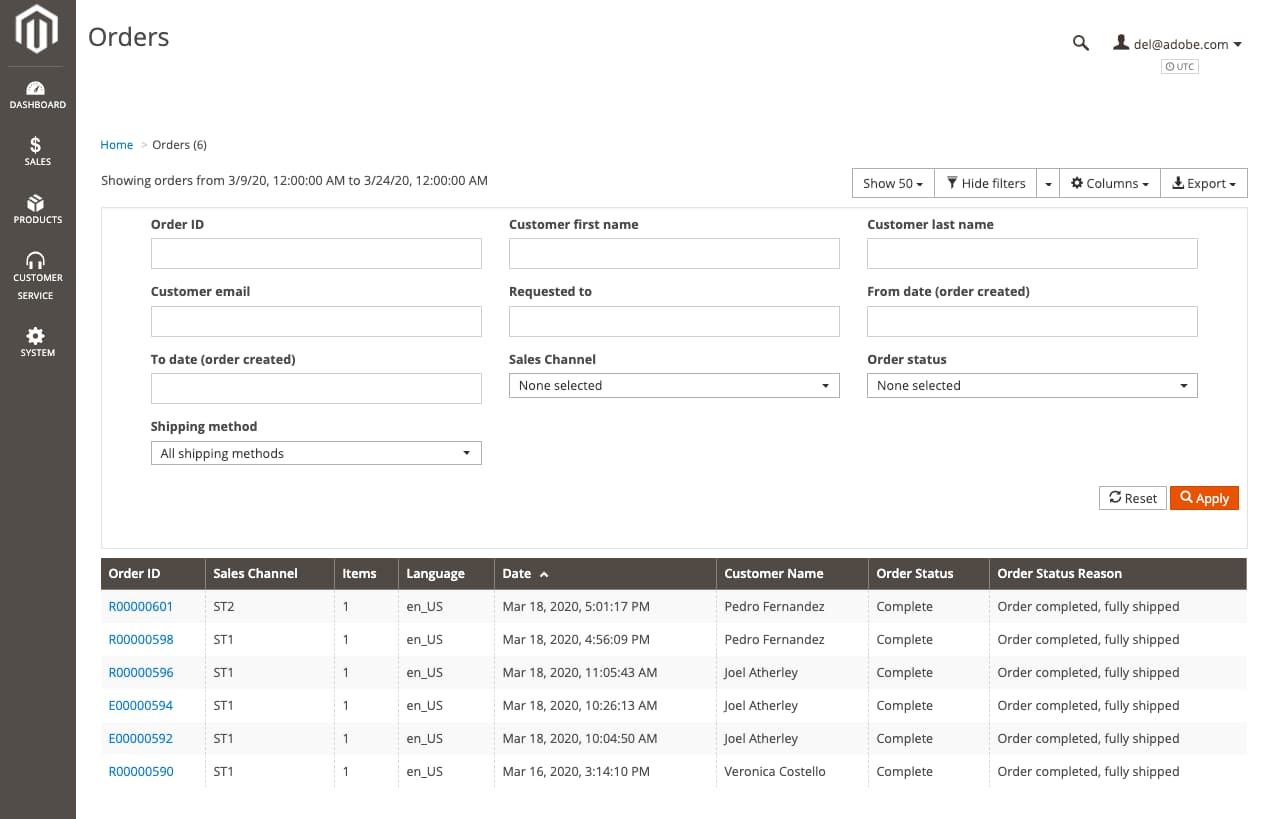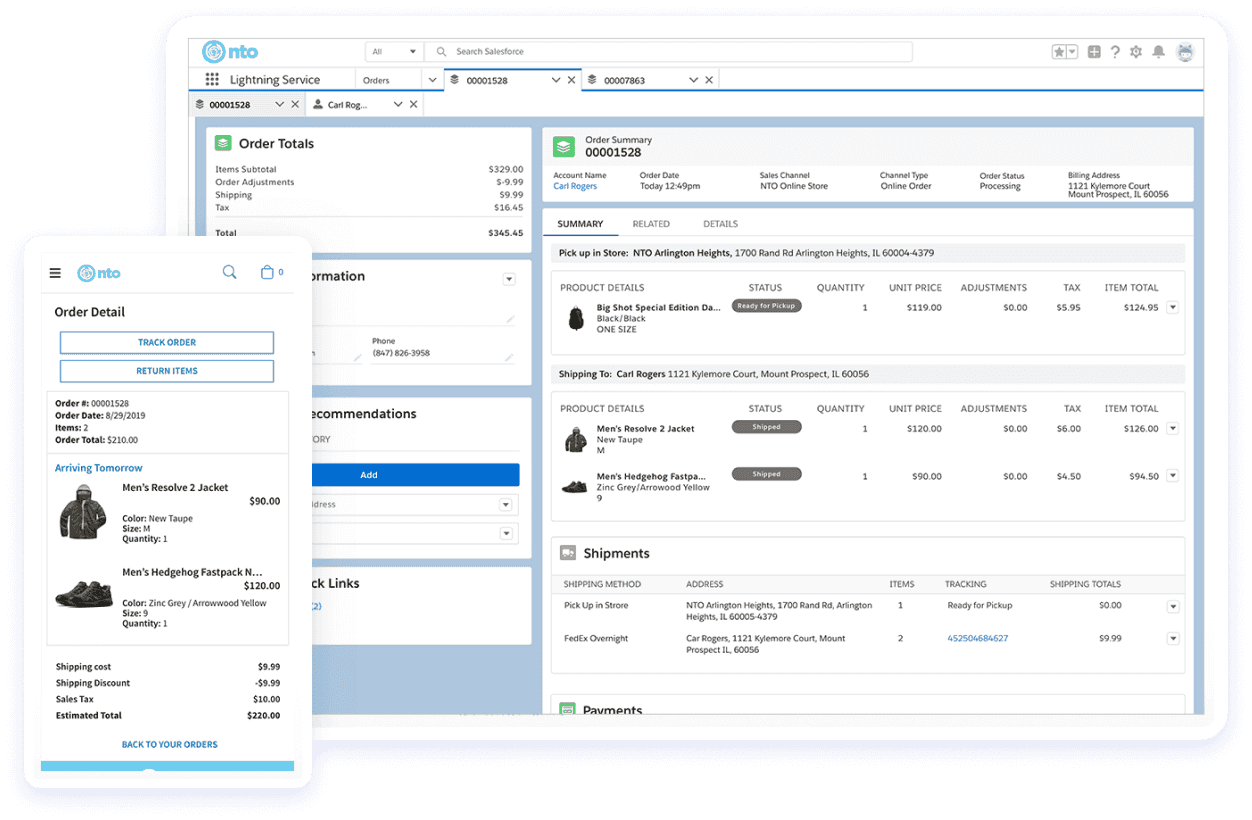
Custom order management software: features, tech stack, and benefits
- Home
- Software development
- Custom order management software
Order management software accumulates orders from online and offline sales channels in one place and facilitates their fulfillment. Itransition builds custom software solutions for order management to help companies automate routine order management tasks, increase their accuracy, and cut administrative costs.
OMS
Brick-and-mortar retailers
Ecommerce businesses
B2C companies
Wholesalers and distributors
Online marketplaces
Manufacturers
Dropshippers
Our scope of custom order management services
Itransition provides a full range of order management software development services, from analyzing your requirements and recommending an optimal feature set to creating and deploying a reliable order management tool to meet your business needs.

Consulting
Our experts can analyze your existing order management workflows and business requirements to help you select the best-fitting features, estimate development costs and timelines, plan the implementation process, and accompany you at every project stage.
Development
We develop custom order management solutions from the ground up and equip them with capabilities for automating order processing tasks, maintaining fulfillment workflows of any complexity, and improving order orchestration practices.
Implementation
We follow best industry practices when implementing custom order management solutions to ensure quick deployment and minimize adoption challenges. We also perform multiple tests to fix any issues, fine-tune the system, and make sure it functions properly when you start taking orders.
Integration
We help retailers, manufacturers, and distributors integrate order management software with corporate or third-party tools to ensure seamless data sharing, reduce manual work, and improve overall business performance.
Discuss your order management project with Itransition
Key features for order management software
Depending on your business specifics and requirements, we can equip your order management solution with suitable functionality to help you quickly manage every stage of the order lifecycle, enable omnichannel fulfillment, and keep your customer satisfaction levels high.
Order creation
- Automated order capture
- Manual order creation
- Order editing
- Order approval and cancellation
- Pre-order support
Omnichannel fulfillment
- Multi-channel order aggregation
- BOPIS (buy online, pick up in-store) operations
- Ship from store and ship to store options
- In-store order collection decline by customer
- Multiple pick-up location management
Customer database
- Customer contact details collection, storage, and editing
- Customers’ order history
- Customer tagging
- Discount calculation
Order processing
- Order search and filtering
- Order routing to fulfillment centers
- Order tracking
- Order prioritization
- Order processing rules creation
- Partial order fulfillment
- Bulk order processing
Shipment management
- Order merging and splitting
- Picking and packing slip generation
- Support of different delivery methods
- Real-time shipped order tracking
- Shipping carrier management
- Delivery cost calculation
- Dropshipping support
Return management
- Return policy establishment
- Return order creation with automated sales order detail completion
- Returned item collection, organizing, and restocking
- Return order routing and tracking
- Refund calculation
- Exchange management
Payments
- Offline and online payment tracking
- Payment status
- Refund payments
- Payment upon delivery
Inventory management
- Centralized stock level information
- Automated inventory calculation and reservation
- Low-stock alerts
- Safety stock configuration
- Manual stock updates
- Backorder support
- Barcode scanning for item tracking
Reporting & analytics
- Summary dashboards
- Order reports by location, day, orders processed, processing time, and fulfillment rates
- Sales reports by channels, products, customers
- KPI and performance reports
- Order and demand forecasting
- Sales trend identification
Order fulfillment process
1
Purchase order placement
A product added to the shopping cart
Checkout
2
Order confirmation
Payment verification
Fraud detection
Checking product availability
Order approval
3
Order processing
Inventory updating
Order routing to a suitable fulfillment center
4
Picking
Order gathering for shipping at the warehouse
5
Packing
Order packaging
Labelling
Packing slip and receipt printing
6
Shipping
Shipping carrier selection
Shipment tracking enablement
7
Delivery
Delivery to the customer or the chosen pickup location
Delivery confirmation
8
Post-sales follow-up
Customer feedback request
Return and exchange handling
Refund payment
Streamline your order fulfillment with Itransition
Essential order management software integrations
We can connect your order management system with the disparate digital solutions you use in your sales operations to enable seamless cross-team data exchange and streamline order fulfillment workflows across the company.
Key integrations
ERP
Sales channels
Warehouse management systems
Accounting software
Shipping carriers’ systems
With an OMS-ERP integration, retailers can get a unified 360-degree view of their supply chain operations, streamline their order-to-cash processes, optimize sourcing and logistics, and ensure accurate financial reporting.
Sales channels
We can connect an OMS to your ecommerce website, online marketplace, and in-store PoS system for automatic order generation, quick payment verification, customer details collection, order details updating, and sharing order statuses with customers.
Warehouse management systems
Order and warehouse management software integration allows for real-time inventory visibility, syncing of stock changes, optimization of order routing, acceleration of order picking and packing, and minimization of human error.
Accounting software
By linking an OMS to accounting software, you can track completed and pending purchase/sales orders, automatically update sales ledgers, ensure timely order reconciliation, and calculate taxes more accurately.
Shipping carriers’ systems
Through integration with shipping carriers’ software, businesses can compare shipping rates, track shipments from the chosen carriers in real-time, optimize the delivery for purchase and sales orders, and gain end-to-end supply chain visibility.
Best order management software
Top order management platforms offer basic and advanced features for order fulfillment and can cater to the functional needs of various business types.
SAP Commerce Cloud offers a dedicated order management service module for viewing and managing customer orders, reviewing and editing shipping details, managing returns and refunds, and checking inventory information.
Key features
- Real-time inventory management across stock locations
Automated order workflow with advanced configuration and extension flexibility
Sourcing
Order splitting
Two distinct user interfaces for customer support and warehouse teams, Backoffice Customer Support Cockpit and Backoffice Order Fulfillment Cockpit - Returns and refunds creation and management
Fraud reports, payment details, and customer information viewing
Customer support integration
Accelerator integration
Omnichannel sales support
Limitations
- Requires training
- No free trial
Pricing
- Price upon request
Best for
- Companies of all sizes
Magento Order Management System is a flexible, all-in-one solution for orchestrating and executing orders from any sales channel, managing inventory, and centralizing shipments.
Image title: Example of the Orders view in Magento OMS
Data source: omsdocs.magento.com — Orders

Key features
- Highly configurable to allow for specific use cases and product sets
Consists of several modules streamlining all ecommerce operations
Omnichannel shipment and fulfillment
Order status, modification, and comments
A smart sourcing engine with filters and scoring to support order flows
Stock and sales channels creation and configuration via a built-in admin panel or API - Offline and multi-capture payments
Returns and refunds management
Virtual products and unlimited stock support
Pre-orders, bundles, and product-related services
Live reports
Connector- and API-based integrations
Limitations
- A steep learning curve
- Available for paid Adobe Commerce license owners
Pricing
- Price upon request
Best for
- Small, medium, and large companies
Salesforce offers a customer-centric order management system built on Salesforce Commerce Cloud for handling order capture, fulfillment, shipping, payment processing, and customer service.
Image title: Example of order pages in Salesforce Order Management
Data source: Salesforce

Key features
- Omnichannel fulfillment
Automated order fulfillment, payment capture, and invoice generation
Drag-and-drop customization of the business logic behind the order management processes
Distributed order management with automated order routing
Payment authorization, capture, and reconciliation along the fulfillment workflow
Customer self-service for checking order statuses, canceling orders, or initiating returns - Service Cloud connection to give a single view of the order and service history
Reports for order fulfillment and payment information retrieval and analysis
Salesforce mobile app
Prebuilt app integration for order management customization
B2C Commerce storefront integration
Salesforce Vendor EDI app
Limitations
- Requires an annual contract
- A steep learning curve
Pricing
- Starter plan at € 0.30/order billed annually
- Growth plan at € 0.50/order billed annually
- 30-day free trial
Best for
- Small businesses to large enterprises
OMS development roadmap
1
Planning
Analysis of the client’s workflows and requirements for the future order management solution
2
Design
Architecture design, hands-on prototyping, specification review and technical sketching, UI/UX design
3
Development
Front-end and back-end development, integration with external systems
4
Acceptance testing
End-to-end acceptance testing and expert supervision
5
Deployment
Deploying the final project, post-release testing, and user training
6
Maintenance & support
On-demand ongoing performance monitoring, software upgrades, repairs, and fixes
Custom OMS cost & development timeline
Cost
The cost of order management solutions varies greatly depending on the project’s complexity and business requirements. The total cost can start at $100,000 for an MVP and reach $400,000 for a complicated solution with advanced capabilities and sophisticated workflows. For companies that want to upgrade their existing solution with new functionality, the cost of modifications can start at $50,000.
Custom software cost factors:
- Development team composition and pay rate
- Number, type, and complexity of features
- Software development duration
- Data migration needs
- Project complexity
- Number and complexity of integrations
- Technology stack
- Staff training
Time
It can take 10 to 30 weeks to develop a custom order management solution depending on your requirements. The more complicated the system is, the more time the development process will take.
Time factors:
- System complexity
- Use of open-source tools
- The number of simple and advanced features
- Development team size
- The number and complexity of integrations
- Project management practices
Order management software benefits
Whether you run a small retail store or a large online marketplace, implementing an order management tool can significantly accelerate and simplify your order fulfillment and improve your business operations.
Improved efficiency
By streamlining order management tasks, an OMS helps merchants reduce order fulfillment time, improve inventory control, optimize the supply chain, and reallocate resources for more complex tasks.
Data transparency
An OMS provides a consolidated, real-time view into each stage of the order management cycle and serves as a single source of truth for your sales, inventory, accounting, and customer data, facilitating informed decisions and more effective strategies.
Centralized customer service
Customer service teams can easily access real-time order or inventory information to help customers. Also, customers can place and track their orders without assistance, which gives them more control and frees customer service staff.
Enhanced accuracy
Order management solutions automate routine tasks, eliminate data silos throughout the sales and fulfillment processes, and minimize manual data entry. This helps prevent mistakes and makes commercial operations more accurate.
Reduced costs
With an OMS, businesses can automate and optimize their back-office order management processes, thus reducing storage, shipping, handling, and labor costs. Moreover, OMS reports provide valuable insights for increasing a business’s cost-effectiveness and profitability.
Enhanced customer experiences
By centralizing order fulfillment in an OMS, merchants can ensure fast and smooth order processing and delivery, offer customer-friendly omnichannel experiences, and increase consumers’ satisfaction with fast, consistent customer service.
Digitize order processing with our order management software
Challenges of OMS implementation
Discovering and addressing possible challenges before adopting an order management system can help prevent operational problems, downtime, and losses.
Choosing the right OMS
With numerous OMS solutions on the market, companies can find it difficult to choose a single platform to meet their business requirements.
You can take the following steps to find the most suitable OMS for your business.
- Identify your current business needs and objectives
Discuss with stakeholders must-have and nice-to-have features in your future OMS, its integration with your corporate systems, and the devices you plan to use for order management. You should also take into account your company’s growth plans to select a solution scalable enough to accommodate increased order volumes.
- Choose between on-premise or cloud-based
You should decide whether to host and manage your OMS in-house or opt for a cloud-based application hosted on the vendor’s servers.
- Create a request for proposal
Submit a request for proposal with your requirements to different order management software providers to help you evaluate their offerings.
- Compare proposals
Once you have several proposals on hand, evaluate whether each system provides sufficient functionality to support your operations and achieve growth goals. Also, consider the pricing of each system to find the one that fits your planned budget.
The necessity of integration
Connecting an OMS with other business applications is crucial for streamlining fulfillment. However, retailers’ existing systems can have different communication protocols, and this lack of standardization makes software integration problematic.
Depending on the software type, two scenarios are possible for syncing a custom OMS solution with ecommerce platforms and other business tools.
- If an organization opts for a custom solution built from scratch, the software development team can create a suitable software architecture and design special connectors to fit the OMS into the company’s digital ecosystem and connect it with your ecommerce website, point-of-sale system, ERP, and WMS.
- If a solution is built on top of a cloud-based, modular OMS platform, communication between the systems can be set up through APIs or prebuilt integration solutions.
Adapting OMS to the company's processes
Many off-the-shelf OMS solutions can’t accommodate unique order processing workflows already in place, forcing retailers to modify them. This can cause inefficiencies, mistakes in order fulfillment, and slower operations.
If you can’t find an out-of-the-box OMS flexible enough to adapt to your business processes, consider turning to custom order management system development services. This way, the software development company can tailor the solution to your unique workflows and business practices.
You’ll need to gather detailed requirements from different teams and communicate them to the developers, together with the specifics of your order lifecycle, roles, and data needs. By analyzing your current workflows, you can identify bottlenecks and weak points the new software can help overcome.
Then, collaborate with the development team to design necessary modules, features, and integrations. Optionally, you can hire the software company post-development to keep your OMS updated and well-performing.
Staff resistance to change
Employees can be reluctant to adopt a new OMS solution, fearing their regular processes will be disrupted or they won’t be able to master the system.
Businesses can apply a few strategies to prevent the rejection of the new OMS and ensure its smooth adoption.
- Communicate clearly the reasons for implementing a custom order management system and its short- and long-term benefits
- Address your employees’ concerns about increased workload, lack of knowledge in technology, or potential job loss
- Before the development stage, ask employees for suggestions about the new system’s features and design to foster their sense of ownership
- Upon implementation, train employees to use the OMS correctly and effectively
- Appreciate your team’s efforts and recognize their achievements
FAQs
How does order management software work?
An order management system consolidates all sales orders in a single digital space and helps organize and automate key steps of an order lifecycle, such as:
- Checking available-to-promise inventory
- Payment data sharing with accounting software
- Order capture and validation
- Returns processing
- Pick, pack, and ship activities
- Exchange request fulfillment
- Shipment confirmation
- Customer account crediting
- Customer communication
How is an OMS different from a CRM system?
A customer relationships management system collects comprehensive customer data like sales history and shopping behavior patterns to help retailers improve their offerings, create effective marketing campaigns, and increase sales.
In the meantime, order management software streamlines fulfillment-related back-office operations and enables businesses to deliver orders faster and increase customer satisfaction.
Both systems help improve customer experience in the long run but focus on different aspects of sales.
What is the difference between inventory management software and an OMS?
An IMS provides visibility into inventory levels and streamlines stock handling at the warehouse.
While also containing stock availability data, an OMS focuses primarily on improving customer satisfaction throughout the entire sales process, from payment to order delivery. In contrast, an IMS helps ensure that the right amount of items is in stock at the right time.
When to opt for a custom OMS?
Building a custom OMS tailored to your specific business processes can be the best option if you:
- Need to integrate an OMS with your legacy software and disparate systems
- Have unconventional, complex workflows
- Use advanced features that aren’t available in out-of-the-box solutions

Service
Retail software development services, solutions & tech stack
Learn how our retail software development company helps retailers and ecommerce businesses deliver great customer experiences through reliable software.

Service
Ecommerce consulting services: key options, platform expertise, and benefits
Discover how retailers can improve their digital commerce strategy and significantly enhance their online store performance with ecommerce consulting services.

Case study
An SAP Commerce-integrated mobile app for a retail chain
Get more details on how Itransition developed a mobile app for an online retail chain based on SAP Commerce.

Case study
Shipping automation software migration to the cloud
Read our case study of migrating an international provider’s legacy shipping automation software to the cloud, helping them enter the SaaS market.